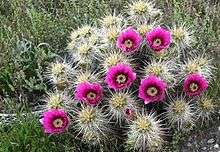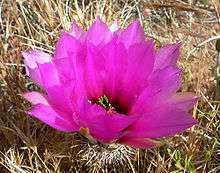Echinocereus engelmannii
The strawberry hedgehog cactus or Engelmann's hedgehog cactus (Echinocereus engelmannii)[1] is commonly found in desert areas of the southwestern United States and the adjacent areas of Mexico, including the states of California, Nevada, Utah, Arizona, Baja California and Sonora.
| Echinocereus engelmannii | |
|---|---|
 | |
| Scientific classification | |
| Kingdom: | |
| (unranked): | |
| (unranked): | |
| (unranked): | Core eudicots |
| Order: | |
| Family: | |
| Subfamily: | |
| Tribe: | |
| Genus: | |
| Species: | E. engelmannii |
| Binomial name | |
| Echinocereus engelmannii | |

Description
It usually grows in clusters, sometimes up to 20 and more stems.[1] Its bright magenta flowers bloom in April in its southern extremes to late May at northern locations. The flowers are borne at the upper half to one third of the stem. They are funnelform in shape, up to 3.5 inches (8.9 centimetres) long with dark-green stigmas. The fruit is very spiny. At first it is green, becoming pink and drying when ripe. The ripe fruit has spines which are easily detached. The seeds are black, and around a tenth of an inch in size.
The stems are initially cylindrical and erect in young plants, but later with the stem base lying on the ground. The stems are usually 1.5 to 3.5 inches (3.8 to 8.9 centimetres) in diameter and up to 25 inches (64 centimetres) high, and obscured by heavy spines. The plants have around 10 ribs, which are somewhat flattened and tuberculate.
Spines variable in color and size. Radial spines are shorter and needlelike, up to 0.8 inches (2.0 centimetres) long, white and arranged in a neat rosette. Central spines number 2 to 7 and are stout, usually twisted or angular, up to 3 inches (7.6 centimetres) long and variable in color: bright yellow, dark brown, grey, and white.
Origin and Habitat: It is one of the most common species of cactus in the south-western USA (southern California, Arizona, southern Nevada, Utah) and Mexico (Baja California down to northern Baja California Sur, Sonora). Still, there are a number of varieties of Echinocereus engelmannii, and some are quite rare. Altitude: From near sea level to 2400 meters. Habitat: It grows in different dry habitats normally in well drained deserts in Sonoran and Mojave deserts, chaparral, pinyon-juniper woodlands, grass, and Great Basin shrub in flats with fine sand on the plain, washes and canyons in the desert, and also in gravelly, sandy, or rocky hillsides, and in mountain ranges. The rich flora and diverse vegetation of the area comprise, among the others, Ferocactus cylindraceus, Mammillaria boogie, Mammillaria microcarpa, Mammillaria tetrancistra, Echinocereus scopulorum, Fouquieria MacDougall, Larrea tridentata, Cercidium microphyllum, Idria columnaris, Opuntia leptocaulis, Opuntia ramosissima and Opuntia engelmannii. The species is abundant throughout its range. Land-use change is a threat affecting this species, however, it is not a major here.
Uses
Echinocereus engelmannii is commonly used as a landscape plant in its native areas. In pot culture it requires well aerated gritty substrate, and a hot and sunny location in the summer. In the winter the plant easily tolerates light frost and wet (if well-drained) soil. In cultivation, it usually does not bloom until it develops 2-3 branches.
References
- "Echinocereus Engelmannii". The American Southwest. Retrieved 2019-02-19.
External links
- Calflora Database: Echinocereus engelmannii (Calico Cactus, Engelmann's hedgehog cactus)
- Jepson Manual Treatment — Echinocereus engelmannii
- USDA Plants Profile: Echinocereus engelmannii (Strawberry Hedgehog Cactus)
- Flora of North America
- Echinocereus engelmannii — U.C. Photo gallery
| Wikimedia Commons has media related to Echinocereus engelmannii. |
